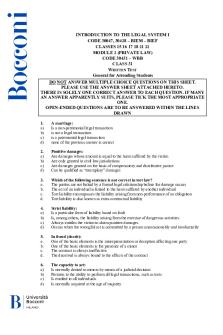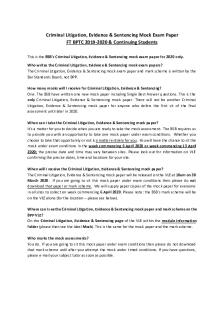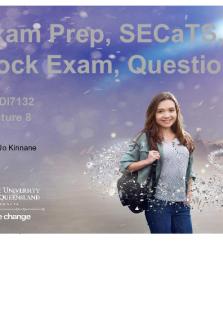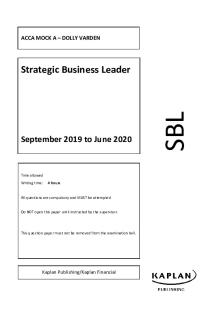2020 nutrition mock exam PDF

| Title | 2020 nutrition mock exam |
|---|---|
| Course | Motor Learning |
| Institution | York University |
| Pages | 5 |
| File Size | 102.5 KB |
| File Type | |
| Total Downloads | 15 |
| Total Views | 144 |
Summary
Exam...
Description
4020 Final Mock Exam 1. Which of the following is true? a. When attempting to lose weight or body fat, the most important factor is one’s energy balance b. Tooth decay and menstrual dysfunction are not associated with bulimia nervosa c. Binge-eating disorder frequently involves purging d. All of the above 2. Nutrients that are transported from the intestines into lymphatic vessels, they arrive at the heart first. a. True b. False 3. Which of the following is false? a. Fructose is the sweetest natural sugar b. Starch has the most amount of energy per gram c. When fibre is eaten, it promotes a sense of satiety along with more mineral absorption d. None of the above 4. Which of the following is false? a. Diabetes, tooth decay, and cancer are all associated with high sugar diets b. Glycemic index is an indicator of how much a food can increase one’s glycemia c. With adequate fat intake, one can still maintain a healthy diet containing very low carbohydrates d. All of the above 5. People with Type 1 diabetes are most often obese, require insulin shots, and their disease was caused directly as a result of eating too much sugar. a. False b. True 6. Of the following pairs, which is incorrectly matched? a. Vitamin K – Hemolysis b. Vitamin C – Scurvy c. Vitamin E – Erythrocyte hemolysis d. Riboflavin – Berberi
7. Which of the following is true? a. Tyrosine is responsible for a lack of hair pigment in individuals with marasmus b. Those with phenylketonuria have an excess of phenylalanine c. Those with phenylketonuria have a deficiency in tyrosine d. All of the above
8. Which of the following is false? a. Glutamic acid is the amino acid involved in the transamination reaction for the conversion to alanine and alpha ketoglutarate b. An individual with reactive hypoglycemia would get elevated glycemia two hours after a sugary meal c. During transamination, keto acid is produced d. None of the above 9. Which of the following is false? a. Coconut oil and palm oil are amongst the highest in saturated fats b. Coconut oil has more PUFA’s that corn oil or butter c. Hydrogenation is the process of adding hydrogen to unsaturated fatty acids in order to create a more solid fatty acid, which makes it easier for consumption d. All of the above 10. The most abundant nutrient BOTH in the body AND in foods is: a. Carbohydrates b. Fats c. Proteins d. Water 11. Which of the following statements is false? a. 50 grams of fat contains 450 kilocalories b. Organic substances are those containing Carbon c. Vitamin B12 is found in abundance in animal foods d. None of the above 12. Which of the following is true? a. Kwashikor has a hallmark sign which is a large swollen belly b. Kwashikor is usually due to a lack of protein in one’s diet
c. Someone with Kwashikor will likely also be deficient in vitamin B12 as well as Iron d. All of the above 13. Which of the following is false? a. The most common form of Vitamin A in the blood during transport is retinal b. Tyrosine and cysteine are both essential amino acids c. Tryptophan can be made from tyrosine d. None of the above 14. Which of the following is false? a. Calcium is a necessary vitamin for the absorption of vitamin D b. Vitamin B6 is required for the body to be able to absorb iron c. Parathyroid hormone is released when there is low dietary vitamin C, in order to promote more vitamin C to be released from the bones d. None of the above 15. During his week-long fast, Danny would have increased urea synthesis in his liver and proteins from his muscles would break down. a. True b. False 16. Which of the following is false? a. A lack of vitamin A in the diet would result in night blindness b. Non-heme iron is absorbed less efficient that heme iron c. A lack of vitamin B12 in the diet would result in pernicious anemia d. All of the above 17. A method used to detect iron deficiency in its earliest stage is to measure the concentration of transferrin in the blood. a. False b. True 18. Which of the following is false? a. Carbohydrate loading is a myth b. Insufficient iron intake by a pregnant woman can result in neural tube defects c. In an adult, the amount of lean tissue the individual has will have the largest impact on their BMR d. All of the above
19. Which of the following is true? a. The thermic effect of food would expend about 250 kilocalories when on a 2500 kilocalorie diet b. The most effective intervention strategy for an individual suffering from metabolic syndrome is a low-sugar diet c. Fat contains about 14 kilocalories per gram d. None of the above 20. An individual trying to gain weight should eat small, frequent meals every day. a. True b. False 21. Which of the following is false? a. Dietary fibre promotes peristalsis and decreases constipation which aid weight loss b. The abdominal region is amongst the worst locations to gain fat in with regards to one’s health c. An increase in one’s body weight results in decreased energy expenditure during exercise d. None of the above 22. Which of the following is true? a. Unlike fat and carbohydrates, anabolism of protein results in thermogenesis b. Having too little fat in the body results in having an elevated body temperature c. Upon follow-up, low carbohydrate shows significantly higher weight loss than low fat diets d. All of the above 23. Which of the following is involved in long-term regulation of energy homeostasis? a. Leptin b. Hypothalamus c. Sympathetic nervous system d. All of the above 24. Which of the following is false? a. Glucose is necessary for generating energy via other substrates b. Losing fat while gaining muscle mass simultaneously is achievable through a highly regulated diet and exercise plan
c. A huge problem with our Western society is a result of hedonic eating d. All of the above 25. Which of the following is true? a. BMR accounts for the majority of a healthy, lean, and fit adult’s daily energy expenditure b. Although wine may have protective benefits, the amount required to achieve these benefits cannot be achieved easily by having one drink per day c. Ketosis, steatosis, dyslipidemia, hypoglycemia, and ketoacidosis are ALL implications of alcohol overconsumption d. All of the above...
Similar Free PDFs

2020 nutrition mock exam
- 5 Pages

Mock exam 2019-2020
- 8 Pages

Mock Exam 2020 Questions
- 2 Pages

Mock Exam 2020 Solutions I2DL
- 20 Pages

Mock exam
- 3 Pages

Mock Exam - exam
- 8 Pages

Mock Exam - exam
- 4 Pages

2020 mock fit1006
- 12 Pages

BSB Criminal Mock 2020
- 52 Pages

SBL MOCK EXAM 1
- 16 Pages

Mock Final Exam - Questions
- 11 Pages

MECO1001 Mock exam 2019
- 6 Pages

Revision & Mock Exam
- 22 Pages

Mock Exam C250 - Mock test questions
- 34 Pages

SBL Mock Test 2020-21
- 22 Pages
Popular Institutions
- Tinajero National High School - Annex
- Politeknik Caltex Riau
- Yokohama City University
- SGT University
- University of Al-Qadisiyah
- Divine Word College of Vigan
- Techniek College Rotterdam
- Universidade de Santiago
- Universiti Teknologi MARA Cawangan Johor Kampus Pasir Gudang
- Poltekkes Kemenkes Yogyakarta
- Baguio City National High School
- Colegio san marcos
- preparatoria uno
- Centro de Bachillerato Tecnológico Industrial y de Servicios No. 107
- Dalian Maritime University
- Quang Trung Secondary School
- Colegio Tecnológico en Informática
- Corporación Regional de Educación Superior
- Grupo CEDVA
- Dar Al Uloom University
- Centro de Estudios Preuniversitarios de la Universidad Nacional de Ingeniería
- 上智大学
- Aakash International School, Nuna Majara
- San Felipe Neri Catholic School
- Kang Chiao International School - New Taipei City
- Misamis Occidental National High School
- Institución Educativa Escuela Normal Juan Ladrilleros
- Kolehiyo ng Pantukan
- Batanes State College
- Instituto Continental
- Sekolah Menengah Kejuruan Kesehatan Kaltara (Tarakan)
- Colegio de La Inmaculada Concepcion - Cebu
